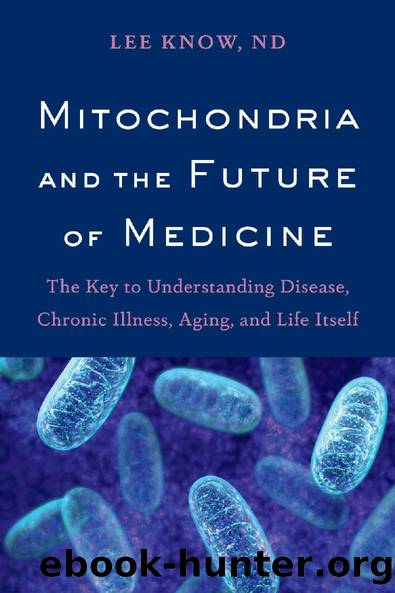Mitochondria and the Future of Medicine: The Key to Understanding Disease, Chronic Illness, Aging, and Life Itself by Lee Know

Author:Lee Know
Language: eng
Format: azw3
Tags: Longevity, Life Sciences, Health & Fitness, Cell Biology, Science, Medical, Microbiology, Holistic Medicine
ISBN: 9781603587686
Publisher: Chelsea Green Publishing
Published: 2018-02-18T23:00:00+00:00
Coenzyme Q10
Coenzyme Q10 (CoQ10) is an antioxidant, a membrane stabilizer, and a vital component in the mitochondrial ETC. It also regulates gene expression and apoptosis; is an essential cofactor of uncoupling proteins and permeability transition pores; and has anti-inflammatory, redox modulatory, and neuroprotective effects.
CoQ10 is a vitamin-like molecule that is naturally present in just about every single cell in our body. Like vitamins, it is absolutely essential to life. However, since our bodies produce CoQ10, it’s not technically a vitamin. In order to produce CoQ10, the cell needs an amino acid called tyrosine, at least eight different vitamins, and several trace minerals. A deficiency of any of these impairs the cells’ ability to produce CoQ10.
Despite the fact that we can produce it, CoQ10 becomes more vitamin-like as we age because we produce less and less with advancing age (with the body slowing its production starting in our late twenties or early thirties). Many believe this is by design, because by our late twenties, our prime reproductive years are behind us, and as we raise our children to take our spot on this finite planet, reduction of CoQ10 is Nature’s way of preparing us for our eventual exit. Considering how important mitochondria and oxidative phosphorylation are to our health and longevity, by reducing the production of this one molecule, the body can start winding things down to make room and free up resources for the next generation.
Although we do get small amounts of CoQ10 from our food, it’s literally a few milligrams daily—not nearly enough for our bodies to benefit clinically, and supplementation becomes increasingly important the older we get. Unfortunately, absorption of this rather large fat-soluble molecule is challenging, which is a main factor limiting its therapeutic use.
Research has shown that oil-based formulations (typically softgels) are much better absorbed, and water-dispersible liposomal or pre-emulsified formulations are even better. Ubiquinol (reduced CoQ10) seems to offer much better absorption than ubiquinone (oxidized CoQ10), and water-soluble (solubilized) ubiquinol is even better absorbed.
Many familiar with CoQ10 also know it as an antioxidant, and its antioxidant properties are directly related to its primary function in the ETC, where it participates in redox (reduction-oxidation) reactions. When it picks up an electron from Complex I or II, CoQ10 becomes reduced. For this reason, CoQ10 is arguably the single most important nutrient for mitochondrial health. If the bulk of free radicals are formed at Complex I, we could probably guess that the next step in the chain would be the bottleneck. In fact, this has not only been confirmed by many studies, but therapeutically, CoQ10 supplementation has been shown to dramatically improve the status of patients with all sorts of health conditions. In a sense, CoQ10 supplementation essentially rescues failing bioenergetics, and targets the main site of free-radical production.
CoQ10 can even take free radicals and put them (or more specifically, their electrons) to good use, as it can bring those rogue electrons back into the ETC for energy production. But even more importantly, this antioxidant activity will help
Download
This site does not store any files on its server. We only index and link to content provided by other sites. Please contact the content providers to delete copyright contents if any and email us, we'll remove relevant links or contents immediately.
| Cell Biology | Developmental Biology |
| Entomology | Marine Biology |
| Microbiology | Molecular Biology |
| Biostatistics |
Sapiens: A Brief History of Humankind by Yuval Noah Harari(13041)
The Tidewater Tales by John Barth(12026)
Do No Harm Stories of Life, Death and Brain Surgery by Henry Marsh(6333)
Mastermind: How to Think Like Sherlock Holmes by Maria Konnikova(6227)
The Thirst by Nesbo Jo(5779)
Why We Sleep: Unlocking the Power of Sleep and Dreams by Matthew Walker(5637)
Sapiens by Yuval Noah Harari(4531)
Life 3.0: Being Human in the Age of Artificial Intelligence by Tegmark Max(4496)
The Longevity Diet by Valter Longo(4444)
The Rules Do Not Apply by Ariel Levy(3898)
The Immortal Life of Henrietta Lacks by Rebecca Skloot(3821)
The Body: A Guide for Occupants by Bill Bryson(3791)
Why We Sleep by Matthew Walker(3768)
Animal Frequency by Melissa Alvarez(3750)
Yoga Anatomy by Kaminoff Leslie(3697)
Barron's AP Biology by Goldberg M.S. Deborah T(3629)
The Hacking of the American Mind by Robert H. Lustig(3576)
All Creatures Great and Small by James Herriot(3508)
Yoga Anatomy by Leslie Kaminoff & Amy Matthews(3392)
